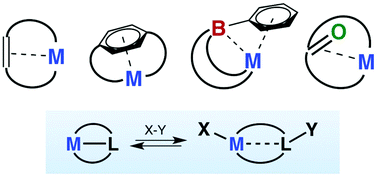Metal–ligand cooperation at tethered π-ligands
Abstract
Metal–ligand cooperativity in homogeneous catalysis is emerging as a powerful tool for the design of efficient transition-metal catalysts. This perspective highlights recent advances in the use of neutral π-coordinating ligands, tethered to a transition-metal center by other donor ligands, as cooperative reaction centers. The state-of-the-art organometallic complexes, including π-coordinating ligands originating from C![[double bond, length as m-dash]](https://www.rsc.org/images/entities/char_e001.gif) C, C
C, C![[double bond, length as m-dash]](https://www.rsc.org/images/entities/char_e001.gif) E (E = O, N) and boron containing moieties, are described here, with special attention on their specific reactivity. Geometric and electronic aspects of ligand design and their influence on the coordination mode and reactivity of the π-system are discussed.
E (E = O, N) and boron containing moieties, are described here, with special attention on their specific reactivity. Geometric and electronic aspects of ligand design and their influence on the coordination mode and reactivity of the π-system are discussed.

- This article is part of the themed collection: Reactions Facilitated by Ligand Design


 Please wait while we load your content...
Please wait while we load your content...